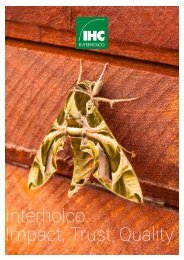Nomenclature Générale des Bois Tropicaux - 7ème édition
(english description below) Cette nomenclature est utilisée pour la mise à jour du 'Harmonized Code System' de l’Organisation Mondiale des Douanes. Dans la circulaire du 5 avril 2005, le Ministère de l’Economie, des Finances et de l’Industrie (France) reconnaît l’ATIBT comme « gardien du temple » de la nomenclature des bois tropicaux. La Commission Européenne mentionne la nomenclature de l’ATIBT comme document de référence pour la mise en œuvre du RBUE. Depuis 1954, l’ATIBT a établi et mis à jour une nomenclature des bois tropicaux faisant correspondre chaque espèce botanique avec un nom pilote reconnu internationalement. La détermination du nom pilote d’une essence est cruciale, car sa commercialisation dépend très largement de l’adoption de ce nom par le public. Le nom pilote assure la protection de l’appellation commerciale de l’essence et l’intégrité des propriétés qui lui sont attribuées, sans risque de confusion. The 1982 version of the general timber nomenclature has finally been updated as some of the 1,750 identified species, are no longer traded, while others, which were not previously included, are now on the market. The present revision has also integrated changes related to new taxonomy, in order to reflect the latest scientific developments. This Nomenclature has been used for the Harmonized Code System, updated by the World Customs Organization. The French Ministry of economy, finance and industry has given official recognition to ATIBT as the reference for the tropical timber nomenclature (NOR: PRMX0508285C of April 5th 2005). The European Commission refers to ATIBT nomenclature as a reference document for the implementation of the EUTR regulation. Since 1954, ATIBT has established and updated a nomenclature of tropical wood, linking each botanical species with an internationally recognized pilot name. A sigle wood species may have many common names; when trading across different countries, this may lead to confusion. Fixing the pilot name of a timber species is crucial, to protect the commercial denomination of the species and guarantee the veracity of the properties linked to that species, without confusion.
(english description below)
Cette nomenclature est utilisée pour la mise à jour du 'Harmonized Code System' de l’Organisation Mondiale des Douanes. Dans la circulaire du 5 avril 2005, le Ministère de l’Economie, des Finances et de l’Industrie (France) reconnaît l’ATIBT comme « gardien du temple » de la nomenclature des bois tropicaux. La Commission Européenne mentionne la nomenclature de l’ATIBT comme document de référence pour la mise en œuvre du RBUE.
Depuis 1954, l’ATIBT a établi et mis à jour une nomenclature des bois tropicaux faisant correspondre chaque espèce botanique avec un nom pilote reconnu internationalement. La détermination du nom pilote d’une essence est cruciale, car sa commercialisation dépend très largement de l’adoption de ce nom par le public. Le nom pilote assure la protection de l’appellation commerciale de l’essence et l’intégrité des propriétés qui lui sont attribuées, sans risque de confusion.
The 1982 version of the general timber nomenclature has finally been updated as some of the 1,750 identified species, are no longer traded, while others, which were not previously included, are now on the market. The present revision has also integrated changes related to new taxonomy, in order to reflect the latest scientific developments.
This Nomenclature has been used for the Harmonized Code System, updated by the World Customs Organization. The French Ministry of economy, finance and industry has given official recognition to ATIBT as the reference for the tropical timber nomenclature (NOR: PRMX0508285C of April 5th 2005). The European Commission refers to ATIBT nomenclature as a reference document for the implementation of the EUTR regulation.
Since 1954, ATIBT has established and updated a nomenclature of tropical wood, linking each botanical species with an internationally recognized pilot name. A sigle wood species may have many common names; when trading across different countries, this may lead to confusion. Fixing the pilot name of a timber species is crucial, to protect the commercial denomination of the species and guarantee the veracity of the properties linked to that species, without confusion.
You also want an ePaper? Increase the reach of your titles
YUMPU automatically turns print PDFs into web optimized ePapers that Google loves.
Liste des noms pilotes des bois tropicaux avec renvoi aux noms scientifiques /// 59
PILOT NAME BOTANICAL NAMES COMMON NAMES
Coula
Couroupita
Coula edulis Baill.
Couroupita guianensis Aubl.
Couroupita subsessilis Pilg.
Couroupita spp.
Attia (CI) ; Coula (GA) ; Ehoume (GA) ; Ewome
(CM) ; Ivianlegbe (NG) ; Kumunu (CG) ; Ngouma
(CM)
Boshcalabas (SR) ; Boulet de canon (GF) ; Canon Ball
(GY) ; Castanha de macaco (BR) ; Couroupita (BR) ;
Macacarecuia (BR)
Cow tree Couma guianensis Aubl. Couma (GF) ; Cow tree (SR) ; Pera (SR)
Crabwood d’Afrique Carapa procera DC.
Cumaru
Cupiuba
Curupay
Curupay-ra
Curupixa
Dabéma
Dalek
Derum
Diania
Dipteryx alata Vogel
Dipteryx micrantha Harms
Dipteryx odorata Willd.
(Syn. Coumarouna odorata)
Dipteryx polyphylla Huber
Dipteryx spp.
Goupia glabra Aubl.
Anadenanthera colubrina Brenan
(Syn. Anadenanthera macrocarpa)
(Syn. Piptadenia macrocarpa)
Parapiptadenia rigida Benth.
(Syn. Piptadenia rigida)
Micropholis gardnerianum Pierre
Micropholis melinoniana Pierre
Micropholis venulosa Pierre
Micropholis spp.
Piptadeniastrum africanum Brenan
(Syn. Piptadenia africana)
Anisophyllea beccariana Baill.
Anisophyllea cinnamomoides Alston
Anisophyllea disticha Baill.
Anisophyllea grandis Burk.
Anisophyllea spp.
Cratoxylum cochinchinense Blume
Cratoxylum formosum Dyer
Cratoxylum p.p.
Celtis adolfi-friderici Rendle
Celtis tessmannii Engl.
(Syn. Celtis brieyi)
Celtis p.p. (AF)
Agogo (NG) ; Alla (CI) ; Bete (GH) ; Dona (CI) ;
Gobi (SL) ; Kowi (SL) ; Krupi (GH) ; Mujogo (UG) ;
Mutongana (UG) ; Toon-Kor-Dah (LR)
Almendrillo (BO) ; Almendro (CR) ; Champanha
(BR) ; Charapilla (PE) ; Cumaru (BR) ; Cumaru
ferro (BR) ; Cumarurana (BR) ; Ebo (HN) ; Gaiac
de Cayenne (GF) ; Koemaroe (SR) ; Kumaru (GY) ;
Sarrapia (CO) ; Sarrapia (VE) ; Shihuahuaco amarillo
(PE) ; Tonka (SR) ; Tonka Bean (GY)
Bois caca (GF) ; Cachaceiro (BR) ; Capricornia (PE) ;
Chaquiro (CO) ; Congrio blanco (VE) ; Copi (GY) ;
Cupiuba (BR) ; Goupi (GF) ; Kabukalli (GY) ; Koepi
(SR) ; Kopie (GF) ; Saino (CO) ; Sapino (CO)
Angico (BR) ; Cebil (AR) ; Curupay (AR, PY) ;
Huilco (BO) ; Paricà de cortuma (BR) ; Vilca (BO) ;
Wilco (BO)
Anchico colorado (BR) ; Angelim amarelo (BR) ;
Angico (UY) ; Angico cedro (BR) ; Angico vermelho
(BR) ; Cebil blanco (AR) ; Colorado (BR) ; Curupay-ra
(AR) ; Guarucaá (BR) ; Gurucaia (BR) ; Horco
cebil (AR) ; Kari kara (BO) ; Kurupay’ra (PY) ; Parica
(BR)
Abiurana (BR) ; Bacu mixa (BR) ; Balata blanc (GF) ;
Barilla de agua (PE) ; Curupixa (BR) ; Grubixa (BR) ;
Grumixava (BR) ; Guajará (BR) ; Ibirá camby (AR) ;
Kudi Biushi (GY) ; Moraballi (GY) ; Pau de Remo
(BR) ; Reini Lout (SR) ; Riemhout (SR) ; Rosadinha
(BR) ; Rosadinho (BR) ; Salgueiro (BR) ; Suikerhout
(SR)
Agboin (NG) ; Atui (CM) ; Bokungu (CD) ; Dabéma
(CI) ; Dahoma (GH) ; Ekhimi (NG) ; Glenren (BJ) ;
Guli (SL) ; Likundu (CD) ; Mbele (SL) ; Mbeli (LR) ;
Mokoungou (CF) ; Mpewere (UG) ; N’Singa (AO,
CG) ; Tom (GQ) ; Toum (GA)
Dalek (ID) ; Weli-Penna (LK)
Baduk-Baduk (MY) ; Derum (MY) ; Geronggang
(MY) ; Lelulus (ID) ; Mampat (ID) ; Mulu (ID) ;
Pedang (MY) ; Pelawan (MY) ; Selunchus (MY) ;
Tnengidjang (ID)
Balze (CF) ; Bawe (BJ) ; Celtis (CI) ; Diania (CD,
CG) ; Dunki (NG) ; Edou (CG) ; Ekembe Bakaswa
(UG) ; Engo (GA) ; Esa-Kokoo (GH) ; Esa-Kosua
(GH) ; Ita (NG) ; Kiliakamba (CG) ; Lohonfe (CI) ;
Lokonfi (LR) ; Odou Vrai (CM) ; Shiunza (KE) ;
Zuwo (NG)














